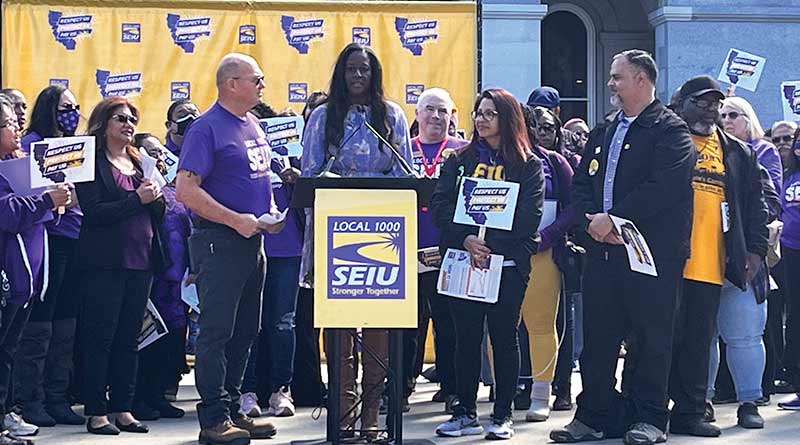State workers demand living wages at Capitol rally
By Sheri Williams
Members of SEIU 1000, the state’s largest public employees union, gathered at the Capitol in March to demand living wages.
“We were essential before the pandemic, we were essential during the pandemic and we are essential now,” said Local 1000 vice president of bargaining Irene Green. “We are committed and we are dedicated to the work we do and if we don’t show up, California doesn’t run. If we don’t work, California does not work.”
SEIU begins bargaining for a new contract in April, and is fighting for the state of California to “Respect us, protect us, pay us.” The new campaign is meant to highlight that many state workers struggle to make ends meet on wages that have not kept up with the cost of living. Many state workers are people of color and women.
“They are saying that we are no longer essential or deserve the recognition or the pay,” Green said.
A recent study from the University of California at Berkeley Labor Center found that about 35 percent, or more than one-third, of state workers represented by SEIU Local 1000, would be unable to support a family of four even in a two-income household with a partner earning the same wages.
The study also found that more than two-thirds, or about 69 percent, of those state workers would be unable to support themselves and a single child on their current wages.
Five percent of SEIU 1000 state workers, the study found, can’t pay for their own basic needs.
“Our research finds that the very people providing essential services to help Californians emerge from the impacts of the pandemic are themselves struggling to make ends meet,” said Enrique Lopezlira, economist and director of the UC Berkeley Labor Center Low Wage Work Program, in a statement. “California cannot recover economically or socially if workers do not earn enough to be self-sufficient and support a family.”
SEIU state workers fill a large variety of jobs, from nurses at state hospitals to custodians in state buildings. The union represents more than 99,000 workers under more than 740 job classifications.
They are fighting for rights and benefits beyond fair pay, including better access to child care and health care.
“I’m fighting for a good contract because there should be affordable daycare available at more state buildings,” SEIU member Tracie Kimbrough said in the campaign.
SEIU member Tamiko Howard said she was fighting for a better contract, “to prevent us from ever getting furloughed again.”
But the classifications that have the hardest time making ends meet are those whose work is critical to the everyday functioning of government. The Berkeley study found that 100 percent of building and maintenance workers were unable to support a family of four even with a partner making the same wage. That was also the situation for 80 percent of health care support workers, and 77 percent of office and administration workers.
The study found that women were overrepresented in those job classifications that did not pay a living wage, as were Black and Latino workers.
